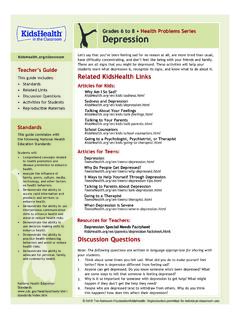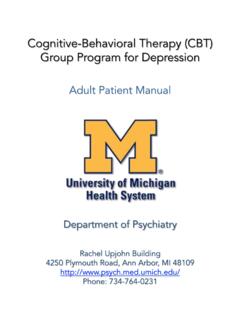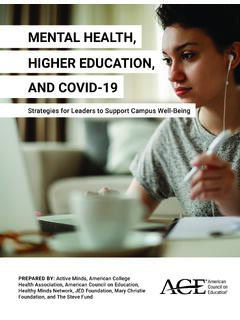Transcription of Practical Teaching Strategies for Students with Autism ...
1 68 BU Journal of Graduate Studies in Education, Volume 7, Issue 2, 2015 Practical Teaching Strategies for Students with Autism Spectrum Disorder: A Review of the Literature Jannelle Murray Abstract The number of children with Autism Spectrum Disorder (ASD) is rapidly increasing, and there is a struggle within our educational system to meet the needs of these Students . While there is a growing awareness among general classroom teachers about Strategies that can be implemented to ensure positive gains for Students with ASD, there is still a need for continuous professional development in the area.
2 This literature review addresses the various challenges that Students with Autism face in educational environments due to their disorder. It also suggests Practical social, behavioural, and academic Strategies that teachers can implement within their classrooms to improve the performance and educational experiences of Students with ASD. The number of Students with Autism spectrum disorder (ASD) who are included and participating in mainstream classrooms has increased over the past few years (Fleury et al., 2014). This presents teachers with additional responsibilities to meet the social, behavioural, and academic needs of these Students .
3 Unfortunately, supports are not always in place to ensure that the needs of autistic Students are being met appropriately. Many general education teachers are not informed about (a) how characteristics associated with ASD can impact student performance, (b) academic profiles of individuals with ASD across content areas, and (c) interventions found to be successful in improving academic outcomes across individuals with ASD (Fleury et al., 2014, p. 69). As a result of this lack of teacher awareness and education, Students with Autism may spend most of their time at school disengaged from learning activities (Muchetti, 2013).
4 On the other hand, according to Manti, Scholte, and Van Berckelaer-Onnes (2013), A vast majority of children with ASD who are provided with appropriate education show improvements not only in academic learning and functional language but also in socialization, adaptive skills and communication, while many of them can take better advantage of their abilities and skills, in this respect that they can use them in a more productive and generalised way. (p. 64) Additional research, specifically to determine what methods might be best for each individual with ASD, is necessary to ensure that teachers have knowledge of the initiatives needed to make a positive difference in their Students lives (Muchetti, 2013).
5 The purpose of this literature review is to address social, behavioural, and academic Teaching Strategies that can be implemented to improve the educational experiences of Students with ASD. The Strategies that are discussed are Practical and easily applicable to both general education and special education learning environments. Each strategy can be used for Students with ASD, regardless of age, but modified appropriately for their individual needs throughout their school years. These Strategies address common issues related to the social, behavioural, and academic challenges that most Students with ASD experience.
6 While dividing the Strategies into the three areas of social, behavioural, and academic interventions, there is still some overlap among the categories because the three domains are interrelated and directly affect each other. For example, improved social skills lead to a decrease in repetitive behaviours (Boyd, Woodard, & Bodfish, 2011). The decrease of repetitive behaviours can lead to increased engagement in learning activities, which directly affects knowledge acquisition (Muchetti, 2013). There is also a noted relationship between the impacts of enhanced social abilities and academic learning; therefore, improving Students social skills BU Journal of Graduate Studies in Education, Volume 7, Issue 2, 2015 69 will in turn improve their academic performance (Fleury et al.)
7 , 2014). The social abilities of Students with ASD also directly affect how they interact with their peers and what types of relationships are formed (Ostmeyer & Scarpa, 2012). Improved peer relationships potentially affect the Students emotional well-being and confidence, which also contribute to improved engagement, and again improved academic performance. How Autism Spectrum Disorder Affects Student Performance ASD is a neurodevelopmental disorder that typically affects a person s ability to communicate and interact socially with others (Centers for Disease Control and Preventions, 2015). Most people with ASD also exhibit challenging or repetitive behaviours.
8 Autism can, but does not always, affect an individual s cognitive ability. Because Autism is a spectrum disorder, it affects each person differently and presents with varying degrees of severity. According to the Centers for Disease Control and Prevention (2015), one in every 68 children has ASD ( Who Is Affected, para. 1). The disorder affects people from various racial, ethnic, and socio-economic backgrounds, and it occurs in males five times more often than in females. The exact cause of Autism is unknown; however, certain factors increase the risk of Autism , such as an existing family history of it and children born to parents of an older age (Centers for Disease Control and Preventions, 2015).
9 Children with ASD experience difficulties in their ability to communicate and effectively interact with others (Jacklin & Farr, 2005). Approximately 30-50% of children with ASD are minimally verbal upon entering school (Muchetti, 2013, p. 359). Most experience impairments in receptive and expressive communication (Fleury et al., 2014). The ongoing struggles for individuals with ASD in social contexts can be attributed to their inability to interpret social cues (Jacklin & Farr, 2005). Individuals with ASD often appear socially awkward, leading to rejection by their peers, while also sometimes becoming victims of teasing and bullying (Ostmeyer & Scarpa, 2012).
10 These circumstances directly affect a child s emotional well-being. For high-functioning children with ASD, such experiences create an ongoing cycle of these children feeling increased anxiety and depression as a result of their social incompetence; in turn, their increased anxiety and depression contributes to their social incompetence. Considering that schools are social environments, one can see a problematic issue for children who are socially impaired (Fleury et al., 2014). Poor academic performance is often noted for autistic children because their social abilities affect their capacity to learn within a classroom (Ostmeyer & Scarpa, 2012).

















